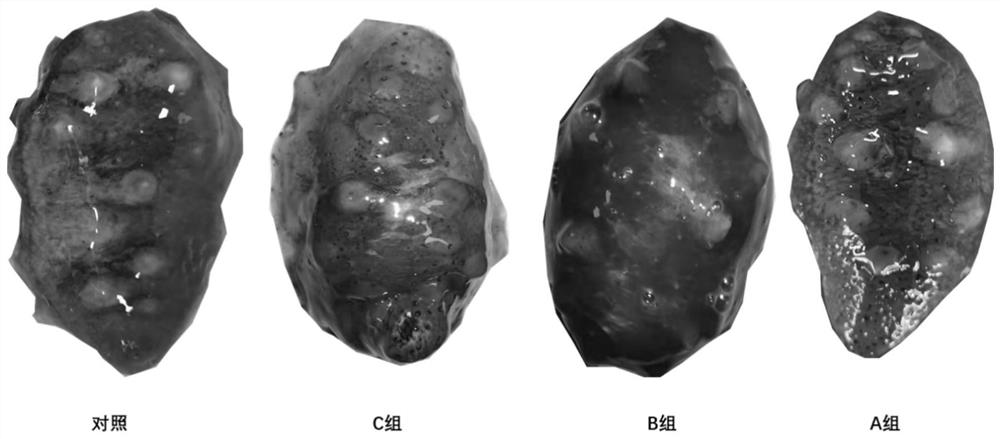Composition for inhibiting skin decomposition of stichopus japonicus and application
A technology of composition and application method, which is applied in the fields of application, climate change adaptation, fish farming, etc., and can solve the problems of short fresh life of sea cucumber, complicated operation of anesthesia, inability to alleviate the impact of sea cucumber, etc.
- Summary
- Abstract
- Description
- Claims
- Application Information
AI Technical Summary
Problems solved by technology
Method used
Image
Examples
Embodiment 1
[0013] Construction of peeling model: 10 fresh sea cucumbers were taken and divided into two groups, UVA irradiation group and control group. The sea cucumbers in the UVA irradiation group were drained of seawater, and the radiation intensity was 15W / m 2 , irradiated with a UVA lamp with a wavelength of 365nm for 40min, and then placed on ice and protected from light. The sea cucumbers in the control group were drained of seawater and stored on ice in the dark without any treatment. Observe and record the number of peeling spots of A. japonicus every 12 hours.
[0014] Data analysis: Use the R language aov function to conduct one-way analysis of variance, and use the aggregate function to calculate the mean and standard deviation. The results showed that there was a significant difference between the UVA irradiation group and the control group from the 12h recording, as shown in Table 1, and at 96h, the skinning degree of the UVA irradiation group was significantly higher th...
Embodiment 2
[0064] After the usage methods and effects of different inhibitors are obtained by the above method, in order to obtain the inhibitor with the best effect of inhibiting peeling, the inhibitors are used in combination.
[0065] 1.1 Grouping:
[0066] According to the effect of the above-mentioned different inhibitors, the following groups were selected: A, Emricasan+Ilomastat+Nafamostat Mesylate soaking group (3 rats), B, Emricasan soaking group (3 rats), C, Ilomastat+NafamostatMesylate soaking group (3 rats), D. Control group (3 rats).
[0067] 2.2 Solution configuration
[0068] Inhibitor A: Emricasan at an initial concentration of 5 mM, Ilomastat at 10 mM, and Nafamostat Mesylate at 10 mg / ml were mixed and diluted with low-temperature ultra-filtered seawater to form A solvent. The final concentrations of its constituents are Emricasan 30 μM, Ilomastat 20 μM, and Nafamostat Mesylate 15ug / ml.
[0069] B Inhibitor: Emricasan at an initial concentration of 5 mM. Use low-temp...
PUM
 Login to View More
Login to View More Abstract
Description
Claims
Application Information
 Login to View More
Login to View More - R&D
- Intellectual Property
- Life Sciences
- Materials
- Tech Scout
- Unparalleled Data Quality
- Higher Quality Content
- 60% Fewer Hallucinations
Browse by: Latest US Patents, China's latest patents, Technical Efficacy Thesaurus, Application Domain, Technology Topic, Popular Technical Reports.
© 2025 PatSnap. All rights reserved.Legal|Privacy policy|Modern Slavery Act Transparency Statement|Sitemap|About US| Contact US: help@patsnap.com



